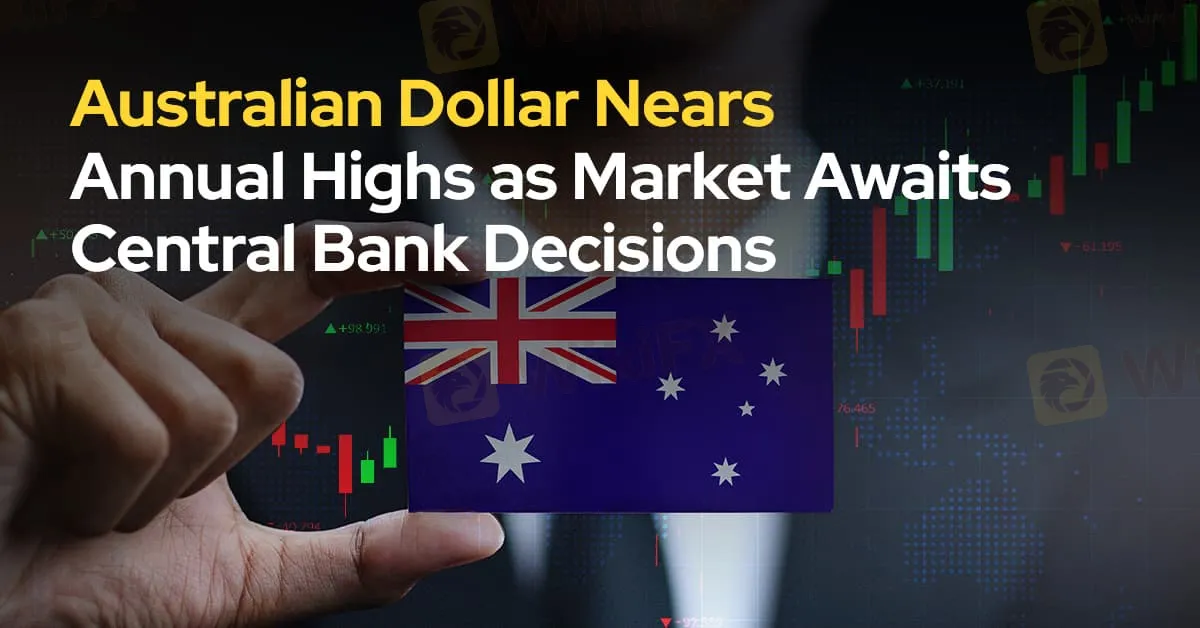简体中文
繁體中文
English
Pусский
日本語
ภาษาไทย
Tiếng Việt
Bahasa Indonesia
Español
हिन्दी
Filippiiniläinen
Français
Deutsch
Português
Türkçe
한국어
العربية
Australian Dollar Nears Annual Highs as Market Awaits Central Bank Decisions
Abstract:According to a report, the Australian dollar edged close to its highest point this year, trading at $0.6839 after a solid 0.45% increase.

According to a report, the Australian dollar edged close to its highest point this year, trading at $0.6839 after a solid 0.45% increase. This rise coincides with the Reserve Bank of Australia (RBA) expected to hold interest rates steady, prompting traders to speculate on any signals regarding potential easing. Among 44 economists surveyed, only four foresee a rate cut by December, while traders estimate a 60% likelihood.
The currency's strength is bolstered by recent stimulus measures from the People's Bank of China (PBoC), including a 50 basis point reduction in banks' reserve requirements, which contributed to a slight dip in the yuan. Initially, the yuan fell by 0.16% in offshore trading but later stabilized around 7.0590 per dollar. Markets analyst Tony Sycamore noted that once the RBA's meeting concludes, the Aussie might rally towards 70 cents by the end of the year.
Meanwhile, the Japanese yen remained stable at 143.495 against the dollar as traders anticipated insights from Bank of Japan Governor Kazuo Ueda regarding future interest rate adjustments. The euro, recovering from a nearly 0.5% decline driven by lackluster business activity surveys, was holding steady at $1.1105. Sterling, too, remained near a 2-1/2-year high at $1.33445, supported by the Bank of England's careful approach to potential rate cuts.
In summary, central bank policies and economic trends are pivotal in shaping the current currency landscape, creating an atmosphere ripe for volatility in the markets.

Disclaimer:
The views in this article only represent the author's personal views, and do not constitute investment advice on this platform. This platform does not guarantee the accuracy, completeness and timeliness of the information in the article, and will not be liable for any loss caused by the use of or reliance on the information in the article.
Read more

RM457,000 Forex Fraud: Court Grants Conditional Release, Is Justice Delayed?
A Malaysian magistrate’s court has issued a discharge not amounting to acquittal (DNAA) for two former directors of an investment company implicated in a forex investment fraud case involving RM457,735.50.

Gold Surges to New Highs – Is It Time to Buy?
Recently, gold prices have once again set new records, surpassing $3,077 per ounce and continuing a four-week winning streak. Is It the Right Time to Invest?

Why Does the Yen's Exchange Rate Fluctuate Repeatedly?
JPY Exchange Rate Fluctuations: How Should Investors Respond?

Bridging Trust, Exploring Best—WikiEXPO Hong Kong 2025 Wraps Up Spectacularly
March 27, 2025, Hong Kong—The highly anticipated WikiEXPO Hong Kong 2025 concluded successfully at the city’s iconic Sky100 Observation Deck. Under the theme “Bridging Trust, Exploring Best,” the event was hosted by WikiGlobal, co-organized by WikiFX, and partnered with government entities including FSI Mauritius (Financial Services Institute Mauritius) and Liberland, creating a top-notch platform for collaboration and innovation.
WikiFX Broker
Latest News
Enlighten Securities Penalized $5 Million as SFC Uncovers Risk Control Failures
Why Are Financial Firms Adopting Stablecoins to Enhance Services and Stability?
Experienced Forex Traders Usually Do This Before Making a Lot of Money
Octa vs XM:Face-Off: A Detailed Comparison
When High Returns Go Wrong: How a Finance Manager Lost RM364,000
Bridging Trust, Exploring Best—WikiEXPO Hong Kong 2025 Wraps Up Spectacularly
Fidelity Investments Explores Stablecoin Innovation in Digital Assets Sector
Interactive Brokers Expands Crypto Trading with Solana, XRP, Cardano, and Dogecoin
SEC Ends Crypto.com Probe, No Action Taken by Regulator
Why More People Are Trading Online Today?
Currency Calculator







